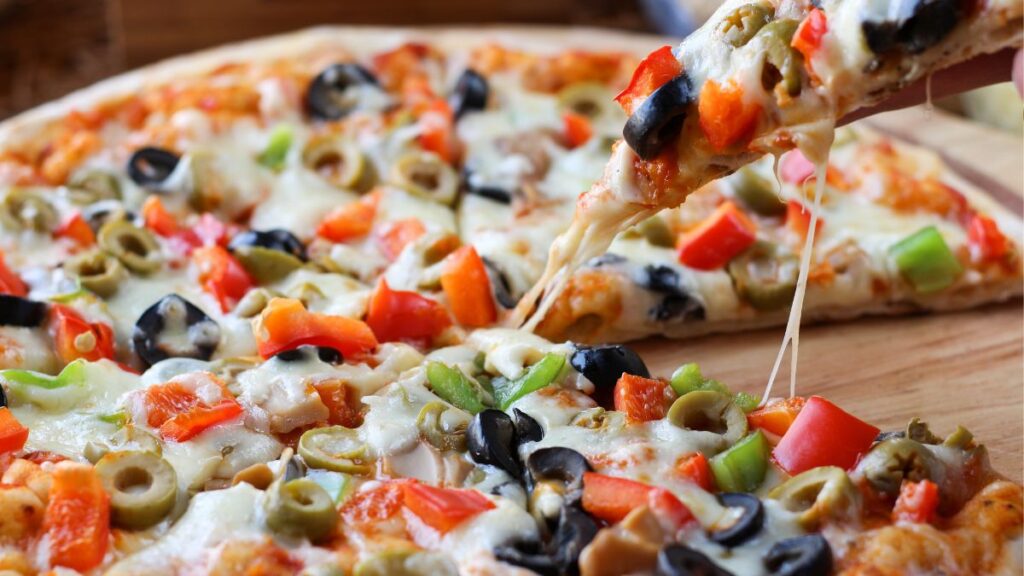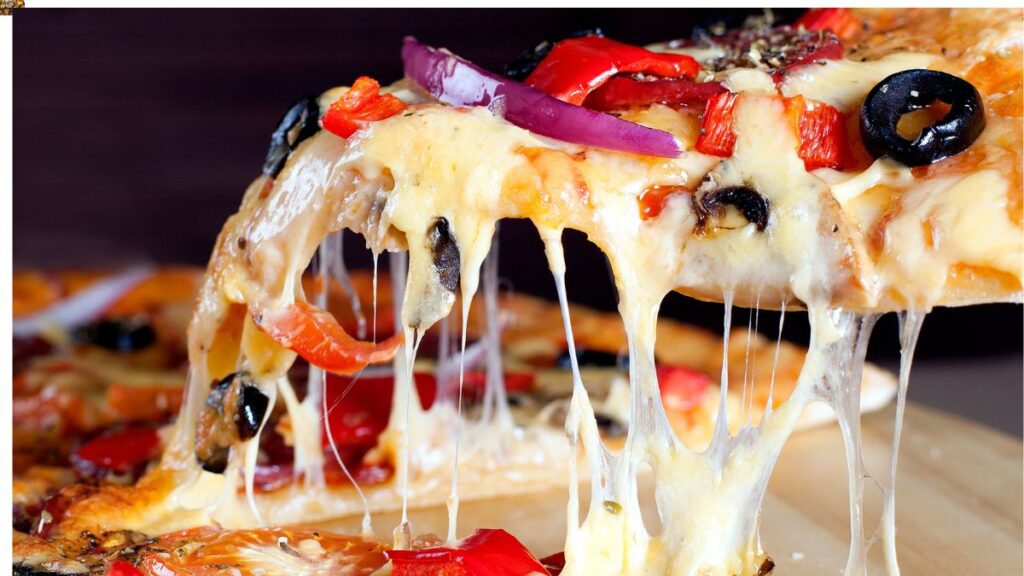Introduction
Pizza has captured the hearts of millions worldwide, and it’s no wonder why this delicious dish has become a staple in diets across the globe. From its humble beginnings in Italy to its current status as a global culinary icon, is more than just food—it’s a cultural phenomenon. In this article, we will explore the rich history of delve into the art of making the perfect pie, and celebrate the community of lovers who unite in their passion for this versatile dish.(23)
1. The Origins of Pizza
The origins of date back to ancient times when various cultures created flatbreads topped with ingredients. However, the modern version of that we know today originated in Naples, Italy, in the late 18th century. Neapolitan was a simple yet flavorful dish, topped with tomatoes, mozzarella cheese, and basil, representing the colors of the Italian flag.

2. Pizza’s Global Journey
As Italian immigrants traveled the world, they brought their love for with them, introducing the dish to new audiences. gained popularity in the United States during the early 20th century, especially after World War II, when soldiers returned home craving the pizzas they had tasted in Italy. Since then, has spread to every corner of the globe, with each region putting its unique spin on the classic dish.
3. Different Styles of Pizza
Pizza comes in various styles, each with its distinct characteristics. Some of the most popular types include:
- Neapolitan: Known for its thin, soft crust, fresh tomatoes, mozzarella, and basil. It’s traditionally cooked in a wood-fired oven at high temperatures.
- New York-Style Pizza: Features a thin, foldable crust and is typically sold by the slice. It’s known for its large size and generous toppings.
- Chicago Deep-Dish Pizza: Characterized by its thick, buttery crust and layers of cheese, toppings, and chunky tomato sauce.
- Sicilian Pizza: A rectangular with a thick, spongy crust, often topped with onions, anchovies, tomatoes, and herbs.
- Detroit-Style Pizza: Features a thick, rectangular crust with crispy edges, topped with Wisconsin brick cheese and tomato sauce.
4. The Art of Making Pizza Dough
The foundation of a great is its dough. Crafting the perfect dough requires skill and patience. It all begins with the right balance of flour, water, yeast, and salt. The dough must be kneaded until it reaches the ideal elasticity and then left to rise for several hours. The result is a dough that is both chewy and crisp, providing the perfect base for toppings.(35)

5. Choosing the Perfect Sauce
The sauce is another crucial component of providing a burst of flavor that complements the toppings. Traditional sauce is made from ripe tomatoes, garlic, olive oil, and herbs such as oregano and basil. However, there are endless variations, from creamy white sauces to spicy barbecue bases, allowing lovers to customize their pies to their liking.
6. Toppings Galore
One of the most exciting aspects of pizza is the endless array of toppings available. From classic choices like pepperoni and mushrooms to gourmet options like prosciutto and arugula, there’s something for everyone. Vegetarians can enjoy a medley of roasted vegetables, while meat lovers can indulge in a carnivorous feast. The key to great is finding the right balance of flavors and textures in the toppings.
7. The Rise of Gourmet Pizza
In recent years, there has been a surge in the popularity of gourmet pizzas, with chefs experimenting with unique ingredients and innovative flavor combinations. Artisanal feature high-quality, locally sourced ingredients and often highlight seasonal produce. From truffle oil to figs, gourmet offer a sophisticated twist on the classic dish, appealing to food enthusiasts and adventurous eaters alike.
8. Pizza and Social Gatherings
Pizza has become synonymous with social gatherings, bringing people together for celebrations, parties, and casual get-togethers. Its shareable nature makes it a perfect choice for feeding a crowd, whether it’s a family dinner, a birthday party, or a game night with friends. The act of sharing a fosters a sense of community and connection among those gathered around the table.
9. The Healthier Side of Pizza
While is often considered indulgent, there are healthier options available for those looking to enjoy a slice without the guilt. Many pizzerias now offer whole wheat or gluten-free crusts, along with an array of fresh vegetable toppings. Additionally, opting for a thinner crust and light cheese can reduce calories and fat content while still delivering great flavor.

10. The Pizza Industry’s Economic Impact
The industry plays a significant role in the global economy, with billions of dollars generated annually. From small, family-owned pizzerias to international chains, the industry provides jobs and supports local agriculture and food production. Innovations such as delivery apps and frozen have further expanded the market, making more accessible than ever.
11. The Future of Pizza
The future of is bright, with endless possibilities for innovation and creativity. As food trends evolve, so too will the world of , embracing new technologies and ingredients. Whether it’s plant-based meats, eco-friendly packaging, or new cooking methods, the industry is poised to adapt and thrive in the years to come.
12. Pizza Festivals and Events
Around the world, lovers gather to celebrate their favorite dish at festivals and events dedicated to all things. These gatherings showcase the diversity of styles and flavors, featuring cooking demonstrations, competitions, and tastings. Whether it’s the annual Naple Festival in Italy or the International Expo in Las Vegas, these events unite enthusiasts in a shared passion for this beloved food.
Conclusion
Pizza is more than just a meal; it’s a symbol of unity and creativity. From its humble beginnings in Naples to its current status as a global phenomenon, continues to captivate hearts and taste buds worldwide. Whether you prefer a classic Margherita or a gourmet creation, there’s a out there for everyone. So, gather your fellow lovers, savor each bite, and celebrate the timeless joy that is .

FAQs
1. What is the most popular pizza topping?
The most popular pizza topping worldwide is pepperoni, known for its spicy and savory flavor that pairs well with cheese and tomato sauce.
2. How did pizza become popular in the United States?
Pizza gained popularity in the United States after World War II when American soldiers returned home with a taste for the they had enjoyed in Italy. The influx of Italian immigrants also contributed to its popularity.
3. Can be part of a healthy diet?
Yes, can be part of a healthy diet when made with nutritious ingredients. Opting for whole wheat crust, plenty of vegetables, and moderate cheese can make a balanced meal.
4. What is the difference between Neapolitan and New York-style pizza?
Neapolitan features a thin, soft crust cooked at high temperatures, while New York-stylehas a thin, foldable crust with a chewy texture, often sold by the slice.
5. What are some unique toppings to try?
Some unique toppings to try include truffle oil, figs, arugula, goat cheese, and smoked salmon. These ingredients can add a gourmet touch to your .
6. How can I make pizza at home without a pizza oven?
You can make at home using a regular oven or a stovetop. Preheat your oven to its highest setting and use a stone or baking sheet to achieve a crispy crust.
7. What is the significance of pizza in Italian culture?
Pizza is an integral part of Italian culture, symbolizing simplicity and quality. It’s a staple dish that represents the essence of Italian cuisine.
8. How has technology impacted the industry?
Technology has revolutionized the industry by enabling online ordering, delivery apps, and efficient kitchen equipment, making more accessible and convenient.
9. What is Detroit-style pizza?
Detroit-style is characterized by its thick, rectangular crust with crispy edges, topped with cheese and tomato sauce. It originated in Detroit, Michigan, in the mid-20th century.
10. Why is pizza considered a social food?
is considered a social food because it’s easy to share and enjoy with others. Its versatility and appeal make it a popular choice for gatherings and celebrations.
11. What are some popular festivals around the world?
Popular festivals include the Naples Festival in Italy, the International Expo in Las Vegas, and the New York Festival, celebrating the diversity of styles and flavors.
12. What is the future of pizza?
The future of pizza involves continued innovation and creativity, with new ingredients, cooking methods, and sustainable practices shaping the industry’s evolution.
